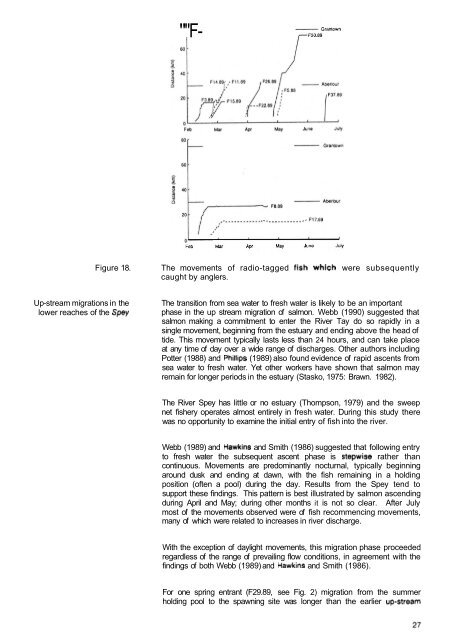( Salmo salar L.) in the River Spey as determined by
( Salmo salar L.) in the River Spey as determined by
( Salmo salar L.) in the River Spey as determined by
You also want an ePaper? Increase the reach of your titles
YUMPU automatically turns print PDFs into web optimized ePapers that Google loves.
""F-<br />
Figure 18.<br />
The movements of radio-tagged fish whlch were subsequently<br />
caught <strong>by</strong> anglers.<br />
Up-stream migrations <strong>in</strong> <strong>the</strong><br />
lower reaches of <strong>the</strong> <strong>Spey</strong><br />
The transition from sea water to fresh water is likely to be an important<br />
ph<strong>as</strong>e <strong>in</strong> <strong>the</strong> up stream migration of salmon. Webb (1990) suggested that<br />
salmon mak<strong>in</strong>g a commitment to enter <strong>the</strong> <strong>River</strong> Tay do so rapidly <strong>in</strong> a<br />
s<strong>in</strong>gle movement, beg<strong>in</strong>n<strong>in</strong>g from <strong>the</strong> estuary and end<strong>in</strong>g above <strong>the</strong> head of<br />
tide. This movement typically l<strong>as</strong>ts less than 24 hours, and can take place<br />
at any time of day over a wide range of discharges. O<strong>the</strong>r authors <strong>in</strong>clud<strong>in</strong>g<br />
Potter (1988) and Phillips (1989) also found evidence of rapid <strong>as</strong>cents from<br />
sea water to fresh water. Yet o<strong>the</strong>r workers have shown that salmon may<br />
rema<strong>in</strong> for longer periods <strong>in</strong> <strong>the</strong> estuary (St<strong>as</strong>ko, 1975: Brawn. 1982).<br />
The <strong>River</strong> <strong>Spey</strong> h<strong>as</strong> little or no estuary (Thompson, 1979) and <strong>the</strong> sweep<br />
net fishery operates almost entirely <strong>in</strong> fresh water. Dur<strong>in</strong>g this study <strong>the</strong>re<br />
w<strong>as</strong> no opportunity to exam<strong>in</strong>e <strong>the</strong> <strong>in</strong>itial entry of fish <strong>in</strong>to <strong>the</strong> river.<br />
Webb (1989) and Hawk<strong>in</strong>s and Smith (1986) suggested that follow<strong>in</strong>g entry<br />
to fresh water <strong>the</strong> subsequent <strong>as</strong>cent ph<strong>as</strong>e is stepwise ra<strong>the</strong>r than<br />
cont<strong>in</strong>uous. Movements are predom<strong>in</strong>antly nocturnal, typically beg<strong>in</strong>n<strong>in</strong>g<br />
around dusk and end<strong>in</strong>g at dawn, with <strong>the</strong> fish rema<strong>in</strong><strong>in</strong>g <strong>in</strong> a hold<strong>in</strong>g<br />
position (often a pool) dur<strong>in</strong>g <strong>the</strong> day. Results from <strong>the</strong> <strong>Spey</strong> tend to<br />
support <strong>the</strong>se f<strong>in</strong>d<strong>in</strong>gs. This pattern is best illustrated <strong>by</strong> salmon <strong>as</strong>cend<strong>in</strong>g<br />
dur<strong>in</strong>g April and May; dur<strong>in</strong>g o<strong>the</strong>r months it is not so clear. After July<br />
most of <strong>the</strong> movements observed were of fish recommenc<strong>in</strong>g movements,<br />
many of which were related to <strong>in</strong>cre<strong>as</strong>es <strong>in</strong> river discharge.<br />
With <strong>the</strong> exception of daylight movements, this migration ph<strong>as</strong>e proceeded<br />
regardless of <strong>the</strong> range of prevail<strong>in</strong>g flow conditions, <strong>in</strong> agreement with <strong>the</strong><br />
f<strong>in</strong>d<strong>in</strong>gs of both Webb (1989) and Hawk<strong>in</strong>s and Smith (1986).<br />
For one spr<strong>in</strong>g entrant (F29.89, see Fig. 2) migration from <strong>the</strong> summer<br />
hold<strong>in</strong>g pool to <strong>the</strong> spawn<strong>in</strong>g site w<strong>as</strong> longer than <strong>the</strong> earlier upetream
















